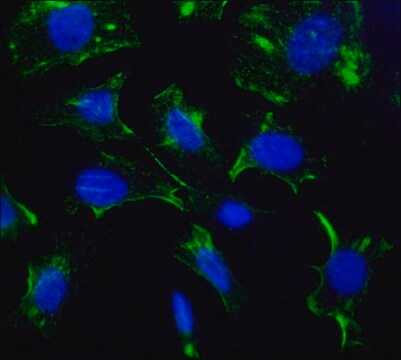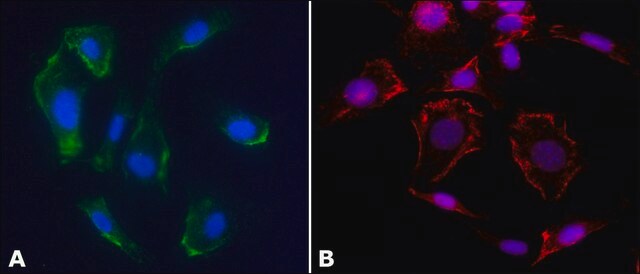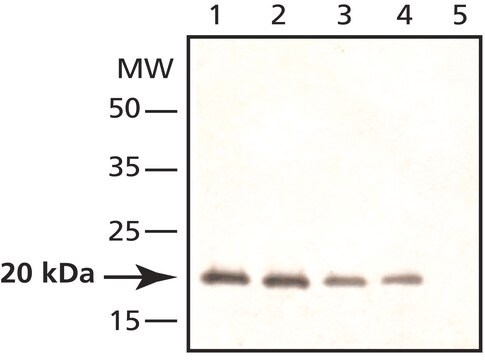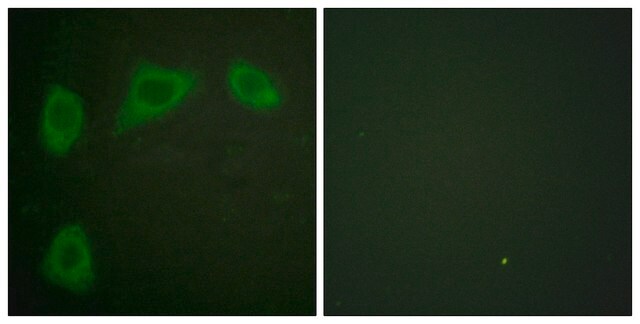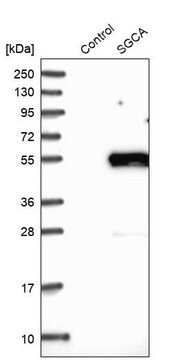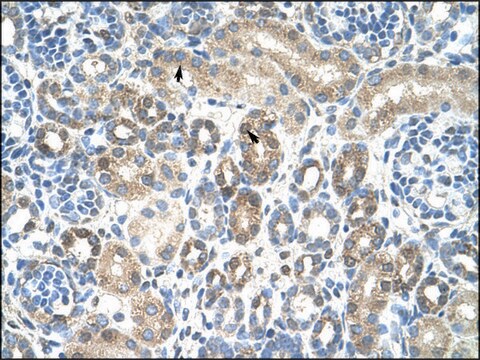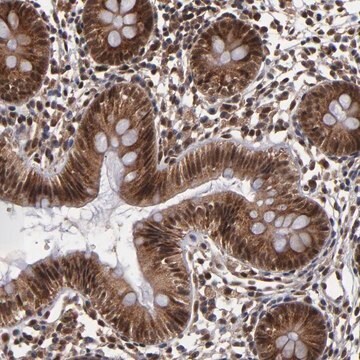推薦產品
生物源
rabbit
品質等級
共軛
unconjugated
抗體表格
affinity isolated antibody
抗體產品種類
primary antibodies
無性繁殖
polyclonal
形狀
buffered aqueous solution
分子量
antigen 22 kDa
物種活性
human, rat, mouse
技術
indirect immunofluorescence: 4-8 μg/mL using HUVEC cell line
indirect immunofluorescence: suitable
western blot: 1-2 μg/mL using whole cell extract of the human endothelial ECV304 cell line and the mouse fibroblast NIH3T3 cell line
UniProt登錄號
運輸包裝
dry ice
儲存溫度
−20°C
目標翻譯後修改
unmodified
基因資訊
human ... CAV1(857)
mouse ... Cav1(12389)
rat ... Cav1(25404)
尋找類似的產品? 前往 產品比較指南
一般說明
Caveolin, a 20-24 kDa integral transmembrane protein, has been identified as a principal component of caveolae membranes. Caveolin (also termed VIP21) exists in several isoforms termed caveolin-1, caveolin-2 and caveolin-3. Caveolin-1 (CAV1) (20- 22 kDa) can exist as two isoforms, caveolin-1α and -1β due to alternative splicing of the mRNA. Caveolin-1 and -2 have similar tissue distribution.
特異性
The sequence is highly conserved in many species, e.g., identical in rat, mouse, bovine, and dog caveolin-1. The sequence is not found in caveolin-2 or caveolin-3.
免疫原
synthetic peptide corresponding to a region at the N-terminus of human caveolin-1 (amino acids 2-20).
應用
Anti-Caveolin-1 antibody produced in rabbit has been used in:
- immunoblotting
- immunofluorescence
- immunohistochemistry
生化/生理作用
Caveolin can simultaneously recognize GPI-linked proteins and interact directly with a number of caveolae associated downstream signaling molecules, such as H-Ras, hetero-trimeric G-proteins, annexin-II, epidermal growth factor receptor (EGFR), protein kinase C, src-family tyrosine kinases and nitric oxide synthase (NOS) isoforms. Caveolin-1 participates in angiogenesis and is expected to play a major role in the growth and evolution of cancer. It participates in glucose metabolism by controlling the expression of glucose transporters.
外觀
0.01M 磷酸缓冲盐溶液,pH 7.4,含 15mM 叠氮化钠。
免責聲明
Unless otherwise stated in our catalog or other company documentation accompanying the product(s), our products are intended for research use only and are not to be used for any other purpose, which includes but is not limited to, unauthorized commercial uses, in vitro diagnostic uses, ex vivo or in vivo therapeutic uses or any type of consumption or application to humans or animals.
未找到適合的產品?
試用我們的產品選擇工具.
推薦
儲存類別代碼
12 - Non Combustible Liquids
水污染物質分類(WGK)
nwg
閃點(°F)
Not applicable
閃點(°C)
Not applicable
Ingrid R Niesman et al.
Molecular and cellular neurosciences, 56, 283-297 (2013-07-16)
Microglia are ramified cells that serve as central nervous system (CNS) guardians, capable of proliferation, migration, and generation of inflammatory cytokines. In non-pathological states, these cells exhibit ramified morphology with processes intermingling with neurons and astrocytes. Under pathological conditions, they
Fan Deng et al.
Oxidative medicine and cellular longevity, 2017, 3542149-3542149 (2017-11-29)
Endothelial microvesicles (EMVs), released after endothelial cell (EC) apoptosis or activation, may carry many adverse signals and propagate injury by intercellular transmission. Caveolae are 50-100 nm cell surface plasma membrane invaginations involved in many pathophysiological processes. Recent evidence has indicated EMVs
Brian C Russo et al.
mBio, 10(3) (2019-05-30)
Many Gram-negative bacterial pathogens require a type 3 secretion system (T3SS) to deliver effector proteins into eukaryotic cells. Contact of the tip complex of the T3SS with a target eukaryotic cell initiates secretion of the two bacterial proteins that assemble
Caveolin-1 is involved in reactive oxygen species-induced SHP-2 activation in astrocytes
Yun JH, et al.
Experimental & Molecular Medicine, 43(12), 660-660 (2011)
Study of caveolin-1 gene expression in whole adipose tissue and its subfractions and during differentiation of human adipocytes
Fernandez RJM, et al.
Nutrition & Metabolism, 7(1), 20-20 (2010)
我們的科學家團隊在所有研究領域都有豐富的經驗,包括生命科學、材料科學、化學合成、色譜、分析等.
聯絡技術服務